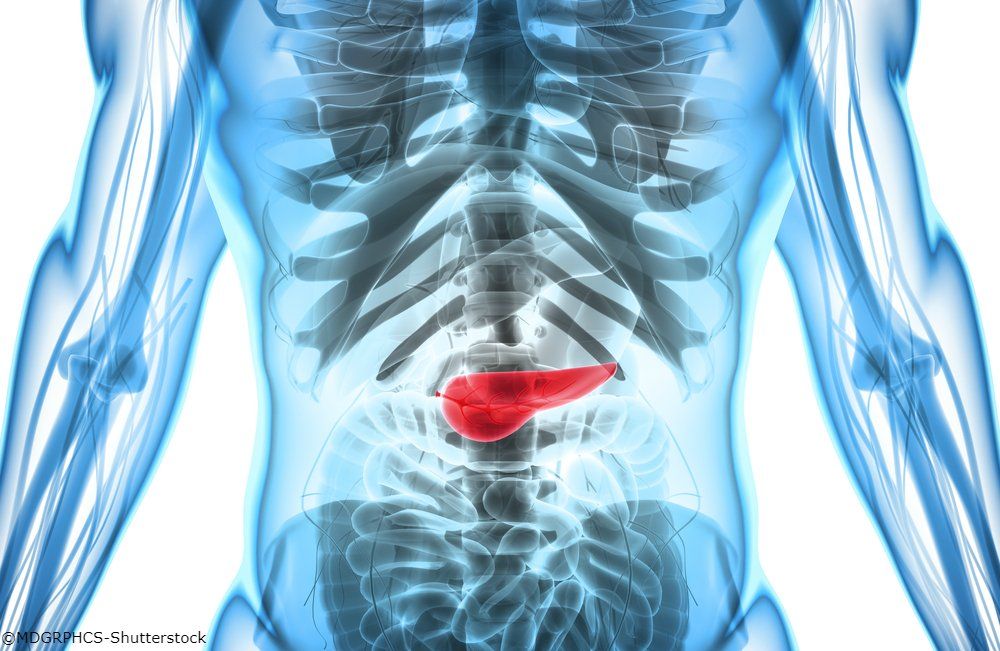Perioperative Modified FOLFIRINOX Shows Encouraging Outcomes in Pancreatic Cancer
Longer survival rates were experienced by patients receiving chemotherapy both before and after surgery vs only after surgery.
Longer survival rates were experienced by patients receiving chemotherapy both before and after surgery vs only after surgery.

When administered in both the neoadjuvant and adjuvant settings, modified FOLFIRINOX (mFOLFIRINOX) was associated with better outcomes with longer survival rates vs surgery alone for patients with pancreatic ductal adenocarcinoma (PDAC) with operable tumors, according to results of a phase 2 study (NCT02047474) published in JAMA Oncology.1,2
Findings revealed that the 1-year progression-free survival (PFS) rate for the intention-to-treat population (n = 46) was 67% (90% CI, 56.9%-100%) tested against the 1-sided alternative of .50 (P = .01), and the Kaplan-Meier estimate of 1-year PFS rate was 67% (95% CI, 55.1 - 82.4).The median PFS was 16.6 months (95% CI, 13.3-40.6) and the median overall survival (OS) was 37.2 months (95% CI, 17.5-not reached); the 2-year OS rate was 59% (95% CI, 45.8%-74.7%).
“When the study launched, even with operable pancreatic cancers, 90% of patients were still relapsing and dying from their cancer eventually,” said first study author Michael Cecchini, MD, co-director of the colorectal program at the Center for Gastrointestinal Cancers at Smilow Cancer Hospital and Yale Cancer Center. “We sought to move chemotherapy up in their treatment regimen and give it before surgery to see if we could improve the outcome for our patients.”
The phase 2, single-arm, open-label, nonrandomized controlled trial was conducted at the Yale Smilow Cancer Hospital for patients with untreated resectable PDAC. To confirm resectability, patients underwent a multidisciplinary review and independent surgical oncology assessment. The primary end point was 12-month PFS rate and secondary end points encompassed median OS, median PFS, ORR by RECIST measures, and AE incidence.
Patients received 6 cycles of neoadjuvant mFOLFIRINOX prior to surgical resection, followed by an additional 6 after surgery. The mFOLFIRINOX regimen consisted of 85 mg/m2 of intravenous oxaliplatin, then a bolus consisting of 400 mg/m2 of intravenous leucovorin, 135 mg/m2 of intravenous irinotecan, and 300 mg/m2 of intravenous 5-fluorouracil, followed by a continuous 2400 mg/m2 intravenous infusion of 5- fluorouracil over 46 hours and pegfilgrastim (Neulasta) on day 3.
Of patients enrolled (n = 46), 80% completed all 6 cycles of preoperative mFOLFIRINOX.Seventy-two percent of patients underwent surgery, with 13% having metastatic or unresectable disease identified intraoperatively and 59% undergoing successful surgical resection per protocol. Three patients discontinued treatment prior to surgery, 2 due to non-RECIST local progression assessed by the treating investigator and 1 with newly developed lung metastases. An additional 22% of patient underwent surgical resection off protocol.
Further, of 37 (80%) patients who completed 6 cycles of preoperative mFOLFIRINOX, the median OS was 46.2 months (95% CI, 24.9-not reached). The median OS has not been reached for the 19 (41%) who underwent 6 pre- and 6 postoperative cycles of mFOLFIRINOX.
Additionally, the overall response rate (ORR) during neoadjuvant mFOLFIRINOX was 17% (n = 6/37), and the disease control rate was 97%.
Regarding safety, treatment emergent adverse events (TEAEs) occurred in 100% of patients, with 76% being reported at grade 3 or higher; 28% experienced serious adverse events (SAEs), all of which were grade 3 or higher.
Common AEs occurring at a 20% frequency or greater include fatigue (78%; grade ≥3, 7%), diarrhea (65%; 9%), nausea (59%; 4%), paresthesia (59%; 0%) elevated alkaline phosphatase (59%; 9%), anorexia (46%; 0%), elevated alanine aminotransferase (46%; 7%), anemia (46%; 7%), decreased platelet count (46%; 9%), neuropathy (43%; 7%), abdominal pain (41%; 4%), elevated aspartate aminotransferase (40%; 7%), constipation (35%; 0%), mucositis (33%; 0%), weight loss (33%; 0%), vomiting (33%; 0%), flatulence (30%; 0%), dysgeusia (30%; 0%), hypoalbuminemia (22%; 0%), hyperglycemia (22%; 11%), and edema (20%; 0%).
References
- Cecchini M, Salem R R, Robert M, et al. Perioperative modified FOLFIRINOX for resectable pancreatic cancer: a nonrandomized controlled trial. JAMA Oncol. Published online June 20, 2024. doi:10.1001/jamaoncol.2024.1575
- Chemotherapy before surgery benefits some patients with pancreatic cancer. News release. Yale School of Medicine. Published June 20, 2024. Accessed June 21, 2024. https://tinyurl.com/bdz88ddv
Newsletter
Stay up to date on recent advances in the multidisciplinary approach to cancer.